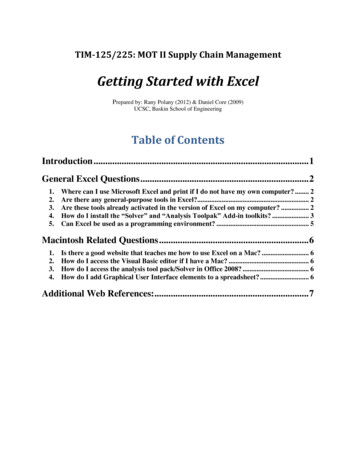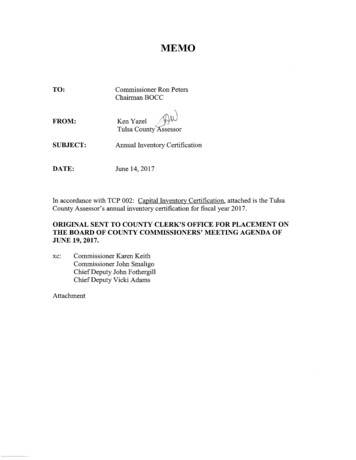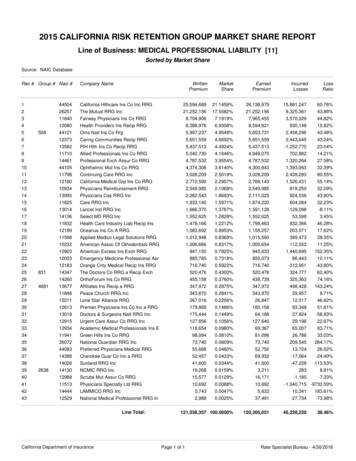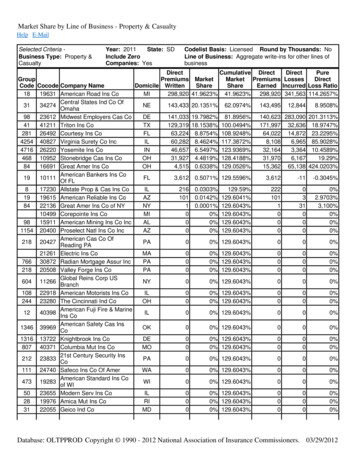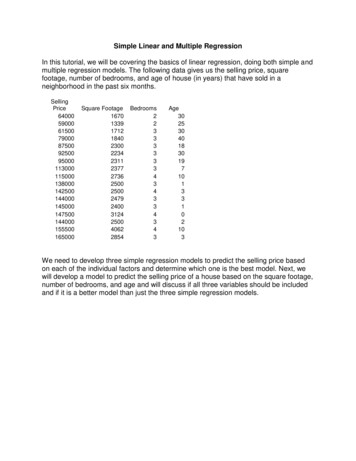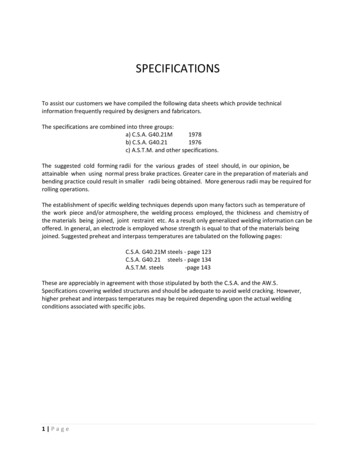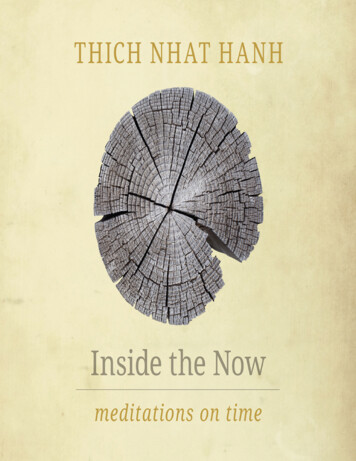
Transcription
Inside the Now
ContentsPrefaceThe Way InNow I SeeNotes
Preface
Inside the Now is a book in two parts: the first is an autobiographicalprologue (The Way In) and the second is a profound contemplation ontime, love, and happiness (Now I See). Thich Nhat Hanh wrote this book inthe summer of 2013, while he was staying at the European Institute ofApplied Buddhism in Waldbröl, Germany.Now I See is an extended free verse poem about time and what it meansto be fully present in the here and now. Thay, (as Thich Nhat Hanh isknown to his students) takes as his inspiration a series of lines about thepassing of time from Vietnam’s most famous epic poem, The Tale of Ki u,in the same way that the thirteenth-century Japanese Zen Master D gentook lines from an earlier Chinese poem as the inspiration for his own greatcontemplation on time, “Being Time,” (Uji,).For many readers, this will be the first encounter with The Tale of Ki u,an historical tale that is part romance and part tragedy, set in a medieval eraof Confucianism and warlords. It is the story of a beautiful young woman,Ki u, who experiences great love but also suffers immense misfortune andhardship. It is Ki u’s love and her suffering that lead her, ultimately, to deepunderstanding and insight. Thay has selected a few vivid moments fromThe Tale of Ki u that reveal something universal about our experience oftime, love, and happiness. For readers who are interested, a brief plotsummary of The Tale of Ki u and context for the quotes are provided in theNotes.You may have already experienced how in moments of a strong feelingof love—whether it is the love of deep friendship, the love between parentsand children, or the love of an intimate relationship—you touch “the now”with greater vividness and intensity. When you can look into a loved one’s
eyes, hold one another close, and see and know one another completely, youmay feel that time stands still.In Now I See Thay shows us how any moment, including a momentexperienced alone with our wonderful planet, can have this same intensityand quality of deep love and connection. Each and every moment is alreadymore beautiful than we could ever have imagined. We just need to learnhow to see it.Now I See begins by establishing that there is no such thing as a heavenwhere everything is pure and blissful. As Thay has often taught, therecannot be a lotus without the mud. In the same way, we cannot havehappiness without suffering: happiness is born from understanding andtransforming suffering. The wonderful present moment is, therefore, a placewhere we know how to embrace and understand our suffering anddifficulties. Using the eloquent poetry of The Tale of Ki u, as well as that ofrenowned Zen masters and his own poetry, Thay shows us how important itis to come back to the now in order to truly cultivate joy, take care ofsuffering, and generate understanding, love, compassion, and insight.Perhaps Thay was inspired by The Tale of Ki u because Ki u’s sufferingresonates closely with the suffering that he and his loved ones experiencedin Vietnam under decades of colonialism, occupation, violence, and war.Now I See is a kind of lotus that has bloomed from the mud of thatsuffering.After completing the manuscript for Now I See, Thay wrote theautobiographical introduction, which he called The Way In. It is a “prequel”to Now I See, describing his years in Vietnam from 1949 until his exile in1966. These were challenging and formative years for Thay, as a youngmonk, poet, scholar, and community-builder struggling to develop inVietnam a Buddhism relevant to the suffering of his time.Thay shares intimately about his deep interconnection with his fellowmonks and poets, teachers, friends, and students; and we learn how poetry,writing, art, and the close bonds of brotherhood and sisterhood nourishedand sustained their spirits. Thay introduces us to those who inspired him,those who supported him, and those whose lives were taken by the ravagesof war. The intense experiences of life, love, and loss described in The WayIn shine light on the insights into time and interbeing presented in Now ISee. Thay’s autobiographic writing reveals how understanding, love,
compassion, and insight are not abstract ideas, but energies which can begenerated in real-life situations, no matter how difficult they may be.In The Way In Thay shows us how poetry can be both a song of insightand an eloquent voice for change. When one of Thay’s poems was firstpublished in The New York Review of Books in 1966, it dominated the frontpage and helped foster a national discussion about the terrible costs of war.His indefatigable efforts to write bravely and eloquently, sometimes at therisk of his own life, can inspire us to discover ways to contribute a spiritualvoice to the issues of our own times—to the challenges of war and violence,hatred and discrimination, and the devastation of our beautiful planet.In the decades since 1966, Thay has developed, from his roots inVietnamese Zen, profoundly effective practices of mindfulness andmeditation that go beyond boundaries of nationality and faith, to touchpeace and healing, and cultivate compassion and insight. If in the 1950s and'60s he was tirelessly searching, in Now I See he reveals, with profoundsimplicity and eloquence, what he was looking for and what he has found.There is no separation between Thay’s spirituality, his poetry, and hisdeep aspiration to engage with and transform the suffering in the world. Justas his early, profoundly spiritual poems and writings called for change inVietnam, so too does this new poetic contemplation, Now I See, call fordeep, personal transformation in each one of us who reads it.This book reveals two different voices: the voice and poetry of Thay asa young monk in The Way In, and the clear and direct voice of a Zen masterin Now I See as he challenges us to open our hearts, seize the moment, andtruly touch the now.We hope that this deeply personal and intimate journey of spiritualdiscovery will show you the way to touch the now so deeply that you willbe able to see who you really are, see those you truly love, and togethertouch the ultimate.Sister True DedicationPlum Village, 2015
The Way InPoetic InspirationFor Thích Nh t H nhAs a bridge of sympathy between Spirituality and PoetryFrom Tr VMy head cushioned on illusory dreamsI carry the soul of poetry in the garment of heaven and earthSleeping amidst fallen autumn leavesGround surges up to touch skyWho let autumn recede into the distance?What is that song rising from the sea?Who painted grey clouds on the canvas of space?
One golden leaf falling, is enough to disturb my heartAs I hold in my hand the seasons of creationAnd befriend earth and skyLife sleeps deeply under my feetBody bound tight under ancient earthFrom a thousand directions comes wind of sky and seaBlowing far and high the wings of a solitary birdI return, at one with emptinessThe poet’s inspiration will endure a thousand years . . .—Tr V
When I was twenty-three years old, I met two impoverished youngpoets, Tr V and Quách Tho i, at the Source of AwakeningTemple in the port district of Saigon, where I was living as a young monk.It was the autumn of 1949, and for three years our whole country had beenengulfed in a terrible war between the French colonial forces struggling toreclaim the country for France, and the resistance fighters battling to winVietnam’s independence.The poets had come to live at the temple and teach Vietnameseliterature to the novices, in order to have somewhere to stay and somethingto eat. The Dragon River Press had recently agreed to publish a collectionof my poems, Reed Flute in the Autumn Twilight. It was my first book.They had given me fifty author copies as payment, which I shared amongstmy friends, so I didn’t have any left to offer to our two young poets.Then, one afternoon I was out teaching novices at the ResponsiveRadiance Temple, on the road the French colonists called Rue de Lorgeril,when Tr V came in looking for me. He had found a copy of Reed Flutein the Autumn Twilight at the Dragon River Press, and had taken it to TaoÐàn Garden to lie down on the grass and read. He fell asleep and uponwaking, the poem “Poetic Inspiration” came to him. He went straight tofind me and offer it to me. Born of this heartfelt exchange, a profoundconnection developed between us.Tr V prefaced the poem with the following dedication: “For ThíchNh t H nh—As a bridge of sympathy between Spirituality and Poetry.”But, I wondered, is such a bridge really necessary?Isn’t poetry already spirituality, and spirituality already poetry?A few months later, in my collection of poems The Golden Light ofSpring, I included two lines on the interconnection and deep interbeing of
poetry and Buddhism in a passage about the Buddha’s passing:May the radiant light of the golden path—source of poetry—Illumine the depths of the darkest night.Song of EternityOf the two poets, we didn’t see Quách Tho i as much as Tr V . Althoughhis writing revealed a strong and bold spirit, his physical constitution wasweak, and within a few years he had succumbed to tuberculosis. Amongsthis manuscripts we found the following poem, “A Dahlia Flower,” whichtouched me deeply:Standing quietly by the fence,you smile your wondrous smile.I am speechless, and my senses are filledby the sound of your beautiful song,beginningless and endless.I bow deeply to you.A few years later, Quách Tho i’s beautiful, miraculous flower reappearedin my poem “April”:. . . The sun is up.One of your tiny petals carries a dewdropimitating the sun, shining forth.The forest doesn’t seem to know you are there,although you have already begun to sing your immortal song.A song that sounds as if it has been there foreverin the solemn atmosphere of the deep forest . . .
The Golden PathWhen I was young, two of the principal sources of my inspiration tobecome a monk were the Zen Master M t Th and the author Nguy n Trng Thu t, who wrote the celebrated book The Watermelon, one of the firstnovels ever written in Vietnamese. Nguy n Tr ng Thu t also wrote adeeply inspiring history of the Zen lineage in Vietnam, which was serializedin the Torch of Wisdom magazine. Zen Master M t Th was a brilliantscholar, with a great vision for the future of Buddhism. His seminal bookThe Spring of Ethics was published in 1942, the year I became a novice. Init, M t Th advocated that Buddhism’s mission should be to bring about “anew spring” for our country. He believed that Buddhist spirituality andethics could open a new path that would liberate humanity from the depthsof doubt, despair, and depravity. Of all my elders, he was the one I feltclosest to in my deep desire to become a monk. He too wrote poetry—poetry that was very gentle and pure.The moon is shining after the rainThe yard fragrant with perfumed breezeThe bell resounds in the evening silenceAsking whose souls have awakened—Zen Master M t ThTh y M t Th ordained at the age of twelve at the Bamboo ForestMonastery in Hu . At that time, Miss Ð m Ph ng, one of Vietnam’s firstfeminists and an important writer, used to come to the temple to teach themonks literature, as well as the modern Vietnamese script. In those days,many monks could read and write better in Sino-Vietnamese, using Chinesecharacters, than with the new system, using the roman alphabet. But as Thy M t Th had already mastered both Vietnamese and Chinese, he was ableto learn French, which then allowed him to read the most up-to-dateBuddhist research being published by French scholars. He later studied atthe Xiao Shan Buddhist Institute in China, and even before receiving the
bhikshu precepts, he had already become a respected professor of Buddhismand a published scholar on the history of Buddhism in Vietnam.The Heart of EternityI feel very fortunate that, as a monastic, I have been close to manywonderful elder and younger brothers. We loved one another even morethan we loved our own blood brothers. We lived, studied, and practicedtogether happily in the spirit of true and wonderful brotherhood. We allloved Buddhism and we all loved our country. All of us wanted tocontribute something, whether great or small, to help resist the Frenchoccupation. Many of us shared a deeply rooted faith that it should bepossible to create a kind of Buddhism that would respond to the needs ofour country, that could be applied in daily life, and that could liberate usfrom our suffering.Yet for eight years, from 1946 to 1954, the war with the French—“thedirty war,” as Jean Paul Sartre would call it—continued to rage around us.The walls of our temple in Hu were riddled with bullet holes; and each daywhen night would come, the ambience of war and death would return. Thesound of gunfire and explosions could be heard in all directions, and bulletsflew over our roof. French soldiers would raid our temples, searching forresistance fighters or food, demanding that we hand over the last of our rice.Monks were killed, even though they were unarmed. My elder brother,Trí Thuyên, was shot dead by the French in the Diamond Mountain Pagoda.Several of my fellow novices, close friends I had studied with at the Báo Quc Institute of Buddhist Studies in Hu , were also killed. My youngerbrother, Tâm Th ng, was shot dead on the Mountain of the Immortals,right beside the Zen Lineage Temple. Young Minh Tâm was shot while outin the rural district of Phong Ði n, and young Tánh Huy n was shot behindthe Auspicious Cloud Temple. Brother Châu Quang was shot right in thecity center of Hu . . .We secretly organized memorial ceremonies for our brothers. We kept aportrait of Th y Trí Thuyên and, below it, these four lines by Th y Tr ngÂn:
In ancient times were we not togetherLighting the fragrant brazier, vowing under the tower of clarity?But now, with the land still not at peaceWhere do you wander lost? Your image here endures.On the anniversary of the death of our younger brother Tâm Thwrote this poem:Tâm Thng, my friend, in this early morning mist,Can you hear the wind calling amongst the thousand pines?On the Mountain of the Immortals, the ancient pagoda is obscuredClouded by gunsmoke and the haze of warHave you seen the bluebird land by the forestUttering without cease its grief-stricken cry?When will it ever stop?Do you hear the heroic strains of musicFull of noblest will and strongest resolve?The source of poetic inspiration risesas a joyous cry from centuries past.In spirit, at the source of the sublime way,One path, two aspirations raised togetherWe go on . . . Remember the spring evenings of years gone byWhen everyone gathered togetherAround the warm hearth, fragrant with sandalwood.We go out . . . Tender blows the wind over mountains and riversSpring falls on a thousand radiant treesThe forceful call of the spirit rises in tumult:“Out now, go! The darkness has prevailed too long,Find the ancient ruins hidden under the distant ocean!ng, I
Bring back the light to the places of shadow!”We step out, hearts still young and full of elationLook at the floating clouds, and the far-off misty mountains and rivers.On the long path, I am impassioned“The heart of that day will be the heart of eternity.”My friend, the mirror of time was never brokenIn the heart of anyone. The source of life is infinite still.This evening, lighting the incense, the smoke surges up,Go, my friend, and visit those who dwell in the undiscovered country!“The heart of that day will be the heart of eternity” are the words of the vowwe chose to patiently pursue, and the ideal of service by which we swore tolive. We knew that the spirit of poetic inspiration, the heart of spirituality,and the mind of love could not be extinguished by death. If those who wentahead were cut down, then those who followed would continue them.
Around 1950, three of us young monks who had been living at theSource of Awakening Temple in Saigon moved out to Vietnam’s centralhighlands to start a community of young monastics at the MiraculousBrightness Pagoda on the Dalat plateau. We had a deep need to cometogether with others to nourish ourselves, and were eagerly searching for away to make Buddhism relevant to the immediate needs of the people.There, with the wholehearted support of the young abbot, we established anInstitute of Buddhist Studies for monks and nuns, and set up a new middleschool and primary school for children—the first private Buddhist schoolsin Vietnam run by monastics.A New SpringFinally, after a decisive defeat at the battle of Ði n Biên Ph in 1954, theFrench were forced to surrender their colonies in Vietnam. The threemonth-long Geneva Conference concluded with a treaty declaring a ceasefire and the division of the country into North and South. The news that thecountry would be partitioned shook the whole population. Many youngmonastics were in a state of shock and confusion. In 1954 the new Buddhistadministration of South Vietnam called me back from the central highlandsto Saigon, and asked me to help renew and modernize the program ofstudies and practice for the young generation of monks and nuns. Inaddition to the classes, we soon set up a student association and beganpublishing a magazine called The New Lotus Season. We initiated the“Engaged Buddhism” movement, having first introduced the term in aseries entitled A New Perspective on Buddhism, which was featured on thefront page of The Democrat newspaper. We wanted to offer a new kind ofBuddhism—a Buddhism that could act as a raft, to save the whole countryfrom the desperate situation of conflict, division, and war.I was a young Dharma teacher and my students in Saigon were just likemy younger brothers and sisters. We shared a common vision and purpose
and, even now, whenever I think of them, I still feel so much gratitude—forthe love between teacher and student, and for the spirit of brotherhood andsisterhood that we shared. This love has endured, and our intimatefriendship has been able to nourish every other kind of love. Looking backtoday, I am very grateful to have always had a good connection with theyounger generation.The spirit of our Engaged Buddhism was the continuation of ZenMaster M t Th ’s vision, but it was still too radical for the majority of theelders in the Buddhist establishment. They dismissed many of our ideas,and steadily began to silence our voices. We felt at a loss. We were young,we had no position or temple of our own. How could we realize ourdreams? Still, we refused to give up hope. We continued to write articles,publish books, and sow the seeds of a new kind of unified Buddhism thatcould respond to the needs of the people, and the needs of our time.Within a few years, Zen Master M t Th passed away. He was onlyforty-nine. Although he was not able to realize his dream in his lifetime,that dream lived on in us, and lives on in us still. After his passing, I tookon his only disciple, Th y Châu Toàn, whom I loved as a younger brother.Perhaps I loved him even more than a blood brother, because we shared thesame dream and aspiration. This was true with all my other brothers. It’sstrange, but we were never angry with each other and we never quarrelled—perhaps because we had such deep faith in one another.Forest RefugeDuring those difficult years, together with a number of close friends andstudents, I did everything I could to create a grassroots Buddhism that couldrespond to the challenges of the times; offering chants and prayers was notenough to stop the war. But we were accused of sowing seeds of dissent,our magazines were eventually closed down, and the setbacks we werefacing in the struggle for peace wore us down. It was then that some of ussuddenly had the idea of building a practice center, a place of refuge tonourish and heal ourselves after periods of intense activity. It would be achance for us to develop concrete Buddhist practices to offer to the people
of our country, to heal our wounds, refresh our spirits, and give all of us thestrength we needed to continue to help change the situation.In August 1957 we sought and found some land in the mountainous Ð iLão Forest, a remote and quiet place with plenty of space, clear streams,and paths for walking. I remember the very first time I drove up the dirtroad into the deep and mysterious forest. I was with Sister Di u Âm, ourfearless and compassionate elder sister, who actively supported our visionwith immense faith and trust. In that moment, as we saw the forest for thefirst time, I knew we were seeing the future. There we established Ph ngB i (the Fragrant Palm Leaves Hermitage), and gradually began to developit into a practice community. We had the idea of planting persimmon treesand selling the fruit to sustain the community, and we planned to call itPersimmon Village.But within four years we were forced to abandon our refuge and scatteronce more to the winds. The government suspected us of clandestineactivities and made it impossible for us to stay. Some of us fled to Saigonand others were forced into a strategic hamlet nearby, set up by governmenttroops for “protection.”Our Plum Village Practice Center in France is a new manifestation ofthe spirit of Ph ng B i. So too was Bát Nhã Monastery, which wasestablished in the hills not far from Ph ng B i. There, from 2005 to 2009,over four hundred of my young Vietnamese monastic disciples built athriving community of practice. Although the government—fearing themonastery’s growing popularity—shut it down in 2009 and forciblydisbanded the community, the young Bát Nhã monks and nuns continue toembody the spirit of both Bát Nhã and Ph ng B i in our practice centersall over the world.
Poetry for PeaceIn 1964, I was invited to become editor in chief of the new weeklymagazine The Sound of the Rising Tide, the official publication of the newlyestablished Vietnamese Unified Buddhist Church in Saigon. I asked myyounger brother Th y Châu Toàn to be editorial secretary, and he in turninvited the acclaimed poet V Hoàng Ch ng to be responsible for thepoetry pages. At that time we had also just established Fragrant Palm
Leaves Press, which was already publishing many influential books byscholars and artists in the capital.V Hoàng Ch ng had recently published the poem “Fire ofCompassion” in honor of Venerable Thích Qung Ðc, our revered elderwhose love, courage, and hope was so great that he set himself on fire inorder to call the world’s attention to the suffering of the Vietnamese people.V Hoàng Ch ng was something of a poet laureate for the South, andalthough he later became widely known for his “drunken poetry” andpassionate, inebriated lifestyle, Buddhism was still his primary inspiration.His poems of the 1960s, written when we were all collaborating on themagazine, were infused with the purity, hope, and peace of meditation.Buddha’s heart stirs with love for this life of sorrow.Transforming his body into snow falling from the four quarters,He becomes a lotus of one hundred petals, a thousand-meter tree.All bitterness soothed away by a single drop of stillness.The Sound of the Rising Tide soon began reporting on the Buddhistcommunity’s efforts to bring about peace and reunify the country. VHoàng Ch ng would provide poems to accompany the photos and news.He and Th y Châu Toàn worked very closely and they would go together togather news about the monks' ongoing hunger strike at the VietnamNational Temple (Qu c T) in protest against the government’s oppression.From time to time, when V Hoàng Ch ng came over to visit us at theBamboo Forest Monastery, he would also bring us a poem. V Hoàng Chng was outspoken and defiant—qualities that would cost him his freedomand his life within a few months of the Communist regime coming to powerin 1975.During the time we were all working on the magazine in Saigon, I wasliving in a little thatched hermitage in the grounds of the Bamboo ForestMonastery, about an hour’s motorbike ride from the city center. Th y ChâuToàn was also living there, and every day he would travel in to themagazine offices by moped. The abbot Th y Dng B n, Th y Châu Toàn,and I had all been novices together in Hu twenty years earlier. My two
brothers made the monastery into a wonderful, happy place for us all to takerefuge in. Th y Châu Toàn was truly an artist and had a real talent formaking beautiful flower arrangements, and Th y Dng B n was an excellentcook and would often treat us to his famous green jackfruit dish. Everyweek we would come together to practice sitting meditation, walkingmeditation, Dharma discussion, and silent meals, and we would imagine thefuture together. Many university students—including sister Ph ng, wholater became Sister Chân Không—would also join us and sometimes ask meto recite poetry for them.It was around this time that the pioneering literary journal Creativitylaunched “free poetry” (poésie libre), a kind of poetry that broke free fromthe very strict traditional rules of meter and rhyme. My poems on war andpeace, many of which were also written in free verse, were being publishedin the poetry pages of The Sound of the Rising Tide. When a collection wasprinted in 1965, government police came to seize them from the bookstores,but they had all already been sold. They were read and heard by manyVietnamese people, and sometimes they were sung with guitaraccompaniment at student meetings, just as songs of protest were beingsung in the United States. Many of them were denounced as “anti-warpoems”—interestingly by both sides fighting in the war.The Sound of the Rising Tide soon became the most popular Buddhistweekly in Vietnam. Fifty thousand copies were printed every week, andthey were delivered by plane to Hu and Danang to meet demand. We heardthat our esteemed poetry editor V Hoàng Ch ng had remarked howstrange it was that my “peace poems” in The Sound of the Rising Tide wereby far the best poems of the free poetry movement, even though I never saidthey were “free poetry.”The lines below are typical of those poems—they are excerpted from“Our Green Garden,” which was translated into English and published inThe New York Review of Books in 1966.Fires spring up like dragon’s teeth at the ten points of the universe.A furious acrid wind sweeps them toward us from all sides.Aloof and beautiful, the mountains and rivers abide.
All around, the horizon burns with the color of death.As for me, yes, I am still alive,But my body and the soul in it writhe as if they too had been set afire.My parched eyes can shed no more tears.Where are you going this evening, dear brother, in what direction?The rattle of gunfire is close at hand.In her breast, the heart of our mother shrivels and fades like a dyingflower.She bows her head, the smooth black hair now threaded with white.How many nights, night after night, has she crouched wide awake,Alone with her lamp, praying for the storm to end?Dearest brother, I know it is you who will shoot me tonight,Piercing our mother’s heart with a wound that can never heal.O terrible winds that blow from the ends of the EarthTo hurl down our houses and blast our fertile fields!I say farewell to the blazing, blackening place where I was born.Here is my breast! Aim your gun at it, brother, shoot!I offer my body, the body our mother bore and nurtured.Destroy it if you will,Destroy it in the name of your dream,That dream in whose name you kill.Can you hear me invoke the darkness:“When will these sufferings end,O darkness, in whose name you destroy?”Come back, dear brother, and kneel at our mother’s feet.
Don’t make a sacrifice of our dear green gardenTo the ragged flames that are carried into the front yardBy wild winds from far away.Here is my breast. Aim your gun at it, brother, shoot!Destroy me if you willAnd build from my carrion whatever it is you are dreaming of.Who will be left to celebrate a victory made of blood and fire?In 1964, the same year I began editing The Sound of the Rising Tide, wealso established the School of Youth for Social Service (SYSS) and foundedV n H nh University. Our vision for the university was to revive the openminded spirit of the educational system of Vietnam’s ancient dynasties, tofree young minds from dogmatic studies, and to teach them the qualities ofunderstanding, love, and trust that could save our country.1 We assigned adifferent brother to lead each branch of our work. One elder brother becamerector of the university; another the director of Fragrant Palm Leaves Press;another, Th y Thanh Vn, became director of the SYSS; and my youngbrother Th y Châu Toàn continued to be editor of The Sound of the RisingTide magazine. Th y Thanh Vn became director of the SYSS when he wasonly twenty-four years old. He was a very gentle and very brave youngmonk, and directed with deep insight, calm, and compassion, the thousandsof young people working in our village reconstruction programs. When hewas accidentally killed by a drunk American soldier driving a militarytruck, Th y Châu Toàn was asked to take over as the director of the SYSS.But within barely two years of starting all these initiatives, I was exiledfrom Vietnam for daring to publicly call for a cease-fire and peacenegotiations. It was the summer of 1966. The SYSS began facingsignificant financial and legal difficulties, and we had to struggle from adistance to mobilize support in order to help the school continue. The SYSShad already realized many remarkable projects: offering relief for warvictims; taking care of orphans of the war; establishing villages for victims
of the war so that they would have a fixed place to live; and building locallyadministered “pilot” villages to demonstrate the ability of the people to selforganize.I can now see clearly that everything that came to be was acontinuation, a new manifestation, of what had come before. The BambooForest Monastery in Saigon, our refuge and base during our years of intenseactivity in the 1960s, w
Thich Nhat Hanh wrote this book in the summer of 2013, while he was staying at the European Institute of Applied Buddhism in Waldbröl, Germany. Now I See is an extended free verse poem about time and what it means to be fully pres ent in the here and now. Thay, (as Thich Nhat Hanh is known

